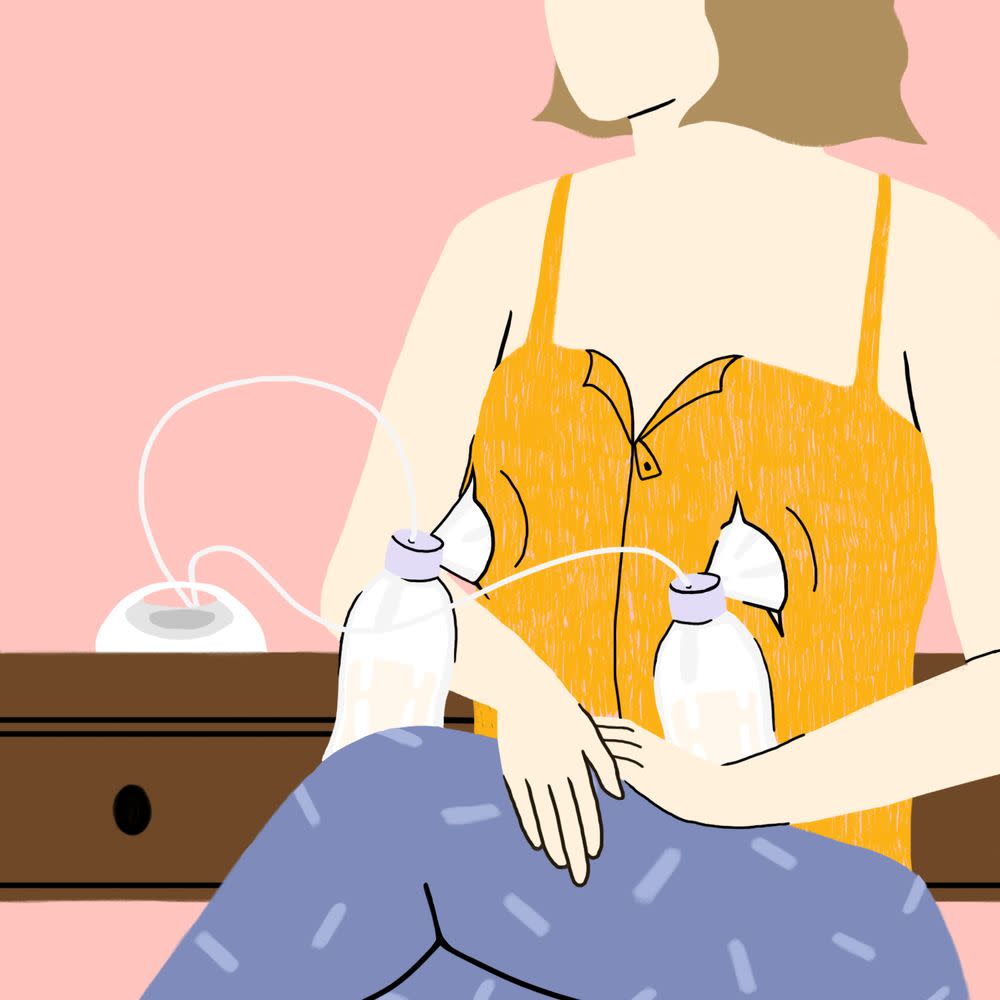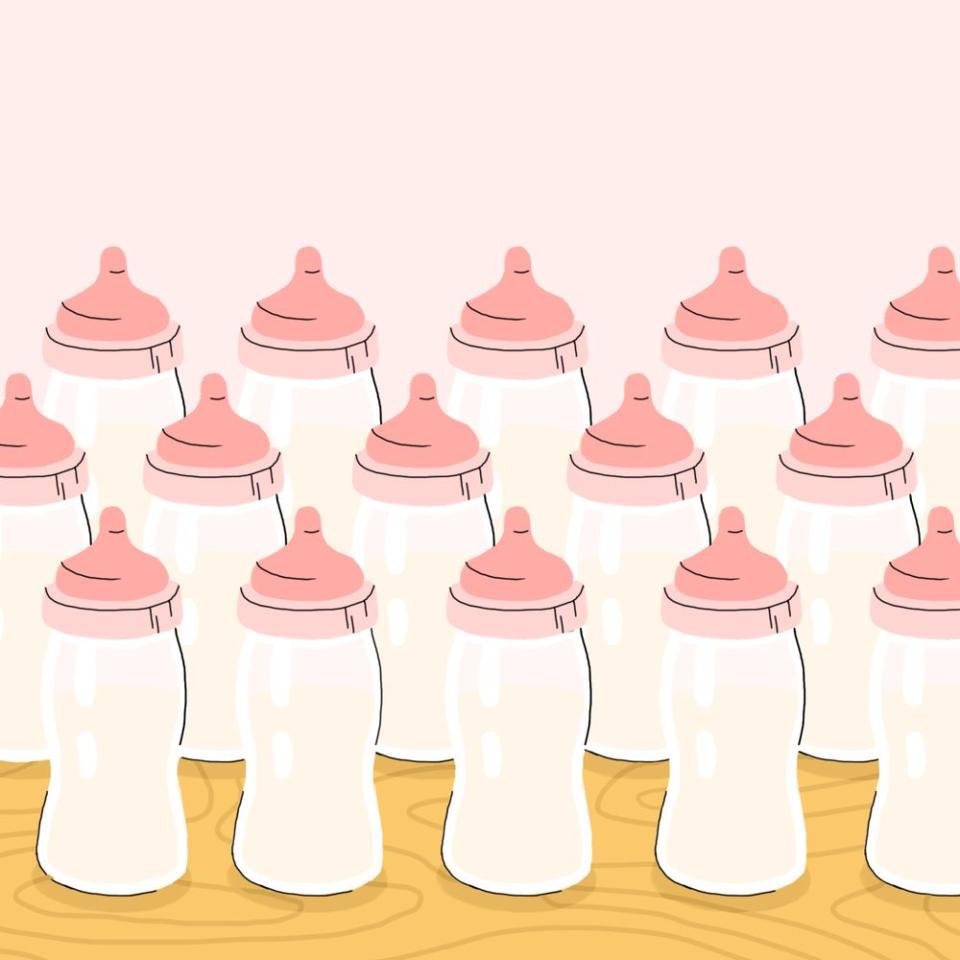More Moms are Exclusively Pumping Breastmilk, Here's Why

The midnight nursing ritual is nothing new to Shafonne Myers, a mom of three from Fishers, Indiana. For more than a decade she has snuggled and rocked one of her three children back to sleep in a dimly lit nursery. But now with her youngest instead of hearing the cooing and suckling of a feeding baby, Myers listens to the whirr of a breast pump extracting her breast milk while the baby in her arms drinks from a bottle.
Myers is one of many new moms who is exclusively pumping her breastmilk rather than direct-nursing her baby. "I nursed for the first 3 weeks and it was hell,” she says. Her baby was having trouble latching due to her inverted nipples and wasn’t feeding well. Her doctor suggested she would need to supplement with formula, a prospect she dreaded.
“I didn’t want to supplement because I really wanted to strictly give her breast milk for as long as I could,” she says. However, as her baby wasn’t gaining weight, she decided to start pumping so that she would know the exact quantity of milk her little one was taking in.
“I was really discouraged but found out that exclusively pumping was the best option for me,” she says.
Breast milk is the ideal standard for infant nutrition, and the World Health Organization encourages exclusive breastfeeding for the first six months of a baby's life. But breastfeeding doesn't always come easy for every mom—many women find it inconvenient, painful, or even impossible for various reasons. In fact, only 24.9% of infants in the United States were breastfed exclusively through six months, according to the Centers for Disease and Prevention’s Breastfeeding Report Card released in 2018.
Veronica Haywood, R.N., co-founder and executive director of Latched, a support group for breastfeeding moms in San Antonio, Texas, says that exclusively pumping may be the only option for some families who want to feed breast milk if either mom or baby has had a medical complication that prevented initial breastfeeding. There are some circumstances like after radiation treatment, or breast surgery, or when taking certain medications, when women may be prevented from breastfeeding,
While Myers was able to nurse and did so for her two older children until work and other issues intervened, nursing wasn’t working this time around and also didn’t fit into her busy schedule.
“The thought of nursing when having to take my other kids places just didn't make sense,” she says. “Pumping works with our lifestyle.” On a recent 10-hour drive to Virginia she was reminded of just how convenient pumping can be compared to breastfeeding, “luckily our truck has an outlet so I just plugged in and pumped with my electric pump,” she says.
While exclusively pumping may sound like a great alternative, it comes with its own set of obstacles.
"The major drawback to exclusively pumping is that it takes a lot of time,” says Kara Manglani, CNM, a nurse-midwife from New York City. “In order to maintain a woman's supply, she has to pump every time she gives a bottle, which is typically every 3 hours, even in the middle of the night.” This is to mimic the regular feeding that babies require which stimulates the production of milk.
The La Leche League International says that most lactating women will need to pump every 2-3 hours to avoid feeling uncomfortable. They also advise moms to use double pumps which help to extract milk in about 15 minutes rather than 30 minutes with a standard single pump.
After pumping, moms then need to feed their baby with a bottle. That is in addition to cleaning bottles and pump parts. All this extra time added to the feeding process can make exclusive pumping feel like a full-time job.
It can also be pricey: While direct nursing doesn't cost any money, pumping will require an electric device for best results. Some insurance plans will partially or fully cover breast pumps, but there are still higher-end devices moms choose to register for. Without assistance, a double electric pump can cost up to $300 or more according to the Le Leche League International. Pumps can also be unwieldy and need to be taken everywhere, although modern versions are fairly compact and could fit in a small backpack.
You’ll also need to find a comfortable space—and depending on your pump, an outlet—wherever you go day or night. Not all public nursing rooms have outlets that are easily accessible, so it could be worth calling ahead if you are traveling or going to spend a significant amount of time in any one location. You'll also need bottles to feed your baby your expressed milk and milk freezer bags or containers if you wish to store any extra supply.

Myers realized quickly just how much forethought and planning had to go into exclusively pumping. "You do have to keep a pretty strict schedule to pump. You have to plan everything around when you pump because when it's time to pump, it's time to pump!" she says. She always carries a manual pump in her baby’s diaper bag for emergencies as well as a nipple shield in case she has to breastfeed.
But for Myers, the extra work is worth it.
Some women may find that even if they are direct nursing, they still need to pump to encourage an increase in their milk supply. Adding pumping to the routine also gives moms the freedom to be away from their baby during a typical mealtime and still produce milk for later if they are exclusively breastfeeding. The biggest difference between those moms who nurse and pump and those who exclusively pump is the absence of direct breast contact with the baby. A fact that concerned Myers, who worried that she wouldn’t feel as strong of a bond with her baby like she did when nursing her other children.
“But I found that I had just as much bonding with my daughter while bottle feeding as I did with breastfeeding and I didn't have to struggle to get situated to breastfeed or make sure that we were in the right position,” she says. “It was just get the bottle and go."
RELATED: 30 Little Ways to Bond With Baby
She also liked being able to track just how much her baby was eating. "This really took the guesswork out of it,” she says. “I knew how much she was eating and that she was on track and gaining weight like she should." This is a true relief for moms who underproduce breast milk and worry that their baby is getting enough to eat. After all, lactation crackers don’t help everyone.
According to Haywood, babies fed with a bottle tend to take in more milk than they would from the breast. In fact, Haywood says that exclusively breastfed babies take in an average of 25 oz (750 mL) per day between the ages of 1 month and 6 months where as a typical range of breastmilk bottle intake is 19-30 oz per day (570-900 mL per day), but of course this will vary for every baby. “The fast, consistent milk flow of the bottle makes overfeeding more likely,” she adds.
Although arguably, for those who do not experience feeding problems, direct breastfeeding is much simpler and quicker than expressing your milk with a pump, Manglani reminds all moms that their choice is the only one that matters.
"Moms need to know that whatever they decide is the right decision for them and their baby. Feeding your baby is a challenge, and what works for one woman might not work for another." Amen to that!

